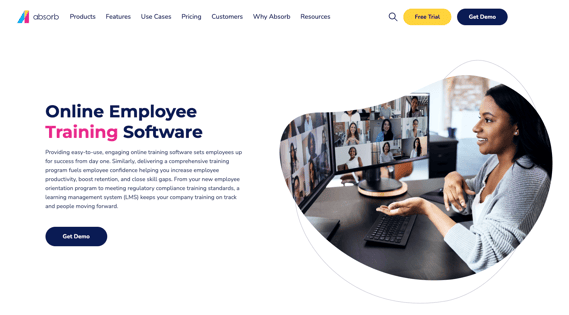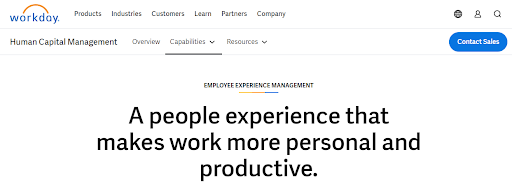Best Employee Onboarding Apps of 2024
Using an employee onboarding app is the best way to streamline and automate the critical function of onboarding. Check out this blog for details on the five best apps out there.
The best way to improve the employee experience is by using an employee onboarding app. Why? Because traditional onboarding limits communication across locations, hybrid work is becoming more popular.
Moreover, in-office employees often need to connect with an out-and-about frontline workforce. In this scenario, digitized onboarding processes help to cut out the chaotic back-and-forth related to manually executed onboarding formalities.
If you want to streamline onboarding using employee onboarding apps, we’ve done the homework to help you choose immediately. We’ve researched and compiled a few tools with valuable features to help you streamline workflows across the different onboarding phases.
But before we dive into that, let’s quickly explore the most desirable features in employee onboarding apps.
What are must-have features in employee onboarding apps?

While different employee onboarding apps have their own unique features, the following are some essential non-negotiables:
- Ability to customize: Every business is unique, and the onboarding process often differs significantly, even within departments of the same company. Therefore, options supporting easy customization and modifications based on evolving job requirements are necessary.
- Compliance with security standards: Onboarding involves collecting, storing, and analyzing sensitive employee data. So, the tool's data exchange mechanism should comply with security standards. For this, encrypted storage is essential.
- A user-friendly interface: Digitized onboarding tools simplify onboarding processes for a recruit. Employees must benefit from its usability and waste less time in completing processes. Therefore, apps must prioritize user experience (UX) design and an intuitive user interface (UI) to be accessible, satisfactory, and memorable.
- Communication tools: Recruits often need clarifications or support during onboarding. Therefore, apps must-have features like sending and receiving messages for direct communication via private messages, group messages, etc.
- Document management and back office: Onboarding processes entail collecting, storing, and safeguarding many employee-related documents in the back office. Hence, document management features become necessary. Robust admin dashboards in employee onboarding apps can help oversee and monitor progress and create a knowledge pool for employee reference.
- Integration with HR tools: Finally, ensuring onboarding occurs concurrently with other HR-related processes, such as payroll creation and training, is a must. Therefore, integration features with other relevant HR tools are necessary. Moreover, tools must work with both desktop and mobile interfaces.
The 5 best employee onboarding apps of 2024
1. Speakap

Speakap is a comprehensive employee onboarding and employee experience app designed to streamline the employee onboarding process, enhancing various aspects of the employee journey.
It offers a hands-on approach to creating better onboarding programs, from formality completion to training and even off-boarding.
With Speakap, you can automate tailored content that helps new hires understand expectations and complete onboarding formalities rapidly, bringing your company's work culture to life through features like gamification and facilitating mentorship programs.
The integration of AI assists in content creation and provides easy steps for your workforce to follow, making the onboarding process smoother and faster, ultimately increasing the chances of successful employee onboarding.
Key features:
- Creates and automates content step-by-step for every phase of onboarding.
- Helps create an employee onboarding checklist that covers all the crucial steps during the different onboarding phases.
- Supports attaching documents, videos, and images for employee reference. You can even translate your existing PDFs and printouts in online format using the AI feature.
- Allows connecting with an onboarding buddy, making things enjoyable for recruits
- Helps to target selected employees with push notifications and emails
- Supports tracking employee progress and seeking feedback
- Helps with employee off-boarding when they leave the organization
Pros
- Customizable
- Mobile-friendly
- Supports automated workflows
- Covers every aspect of the employee journey
- Integrates different phases of onboarding seamlessly with HR functions.
- Easy-to-use UX/UI
- Encrypted data storage and secure communication channels
Cons
- While feature-rich, it's a paid service - no freemium model. However, you can choose plans based on the required features.
2. Absorb

Absorb is a learning management system (LMS) that prepares organizations for growth using training. The tool leverages AI to customize the learner experience for employees. It offers tools to track recruits' progress and push them toward learning required processes.
Pros
- Available on desktop and mobile devices
- Intuitive UX/UI
- Supports integration with existing systems, learning libraries, and authoring formats such as Zoom, LinkedIn Learning, SCORM, or other platforms.
Cons
- It does not account for different employee journeys and is restricted to onboarding
- Onboarding is often more than just training alone, and too much focus on LMS may create obstacles in backend processing.
3. BambooHR

BambooHR is a tool to manage and simplify employee onboarding processes using digitization. Interestingly, while the tool focuses on administrative processes, it does not address training or communication.
Pros
- Track and fine-tune applicants before hiring.
- Collect electronic signatures and ensure a paperless employee orientation process
- Hire employees on the go thanks to their mobile hiring app
Cons
- There is not an extensive training feature essential to onboarding
- There is limited information concerning integrations with third-party tools
4. Workday

Workday is a machine-learning-based tool that helps deliver personalized employee experiences, including an automated and personalized onboarding workflow.
It streamlines the onboarding process by processing applications, making announcements, recommending onboarding tasks, and automating the creation of complex, multi-step onboarding workflows.
This feature ensures that new hires receive a tailored onboarding experience that can include company policy delivery, background checks, benefits enrollment, and access provisioning to necessary apps.
It offers conversational interactions and features to send reminders to smoothen the onboarding process.
Pros
- Its continuous listening platform drives engagement
- It has a modern and easy-to-use interface that packs in many essential features
Cons
The app's listening feature may intimidate recruits rather than reassure them with sustained engagement. They may feel watched over.
5. Kallidus

Kallildus' onboarding solution helps automate onboarding processes to reduce admin work. It allows employers to welcome recruits, create customized onboarding experiences, and run repeatable processes for onboarding.
Pros
- Collect data and sync with applications such as Slack, LinkedIn, GSuite, and others
- Supports cross-functional tasks and can monitor individual progress
- Helps gain visibility into the onboarding pipeline
Cons
- The tool primarily focuses on the initial onboarding steps, such as sending welcome kits, reducing paperwork, etc. Not much information is available regarding the later stages of onboarding, which are equally important.
Inspired? Let's briefly examine some of the most common questions people ask while looking for employee onboarding apps before you finally decide which employee onboarding app to use.
Frequently Asked Questions about employee onboarding apps
What is an employee onboarding app?
An employee onboarding app is a tool that helps streamline and automate bringing new employees into an organization. The technology includes features to enhance efficiency in completing formalities, clarifying roles and expectations, and supporting employees during their initial months. The best tools have applications across the spectrum of different onboarding phases.
What are the 4 phases of onboarding?
- Pre-onboarding involves employee orientation and certain basic formalities, such as collecting documents and signatures.
- Onboarding and welcoming new employees involves introducing them to their work, workplace, and the people they will work with.
- Training helps recruits to understand their role and perform well.
- The final stage is transitioning to the new role and ensuring team productivity and collaboration.
How does an employee onboarding app work?
Employee onboarding apps work on simplifying, managing, and automating workflows across the different onboarding phases.
The tools perform functions like collecting and analyzing data, making reports, and tracking recruits' progress. Specific features and functionalities often vary across different employee onboarding apps. However, the working of most of them revolves around
- Reducing friction during orientation and formality completion by eliminating manual processes. For example, User registration and profile creation, document submission and verification
- Enhancing employee experience and boosting productivity. For example: Guiding workers through different steps.
- Training employees concerning roles. For example, Integrating with learning management systems to deliver training content efficiently.
- Tracking employee progress and identifying pain points to provide a consistent onboarding experience. For example, Helping with conducting employee surveys.
- Promoting enhanced communication at all levels. For example, Sending out automated notifications to inform employees about pending tasks.
Most employee onboarding apps are usable on both mobile and desktop devices.
What are the benefits of using employee onboarding apps?
- Efficiency boost: A well-planned onboarding process post-employee orientation reduces the time required to acclimate to one's role and keeps employees efficient.
- Cost Savings: Glassdoor estimates that if a company hires 50 new employees whose processing of documents takes £25 an hour, companies stand to lose £12,500 per year. While these figures may vary in other countries, automated onboarding eliminates this cost and also helps save time.
- Consistent onboarding experience: 88% of employees feel their company could do a better job onboarding new employees. Employee onboarding apps enhance user experience and help recruits complete tasks smoothly.
- Rise in employee retention: Feeling confused or alienated during onboarding can result in attrition. Thankfully, robust onboarding processes enhance retention by 82%.
- Simplified compliance: Informing employees regarding various rules and regulations helps simplify compliance. Onboarding tools make this easy by disseminating compliance-related information to recruits.
- Enhanced communication: 63% of candidates are dissatisfied with how employers communicate with them. A strong employee onboarding app streamlines initial communication and sets the stage for later efficient employee communication campaigns and engagement.
Leverage your onboarding experience with Speakap
In the journey towards building a cohesive and motivated workforce, investing in the best employee onboarding apps is a strategic imperative. Using feature-rich employee onboarding apps simplifies tasks and enhances the overall onboarding experience.
The apps featured in this blog go beyond mere functionality; they embody innovation, user-friendliness, and adaptability to the ever-evolving needs of the modern workplace.
If you're looking to take the first step to streamline onboarding in your organization, book Speakap's free demo now!

Best Employee Onboarding Apps of 2024

Using an employee onboarding app is the best way to streamline and automate the critical function of onboarding. Check out this blog for details on the five best apps out there.
The best way to improve the employee experience is by using an employee onboarding app. Why? Because traditional onboarding limits communication across locations, hybrid work is becoming more popular.
Moreover, in-office employees often need to connect with an out-and-about frontline workforce. In this scenario, digitized onboarding processes help to cut out the chaotic back-and-forth related to manually executed onboarding formalities.
If you want to streamline onboarding using employee onboarding apps, we’ve done the homework to help you choose immediately. We’ve researched and compiled a few tools with valuable features to help you streamline workflows across the different onboarding phases.
But before we dive into that, let’s quickly explore the most desirable features in employee onboarding apps.
What are must-have features in employee onboarding apps?

While different employee onboarding apps have their own unique features, the following are some essential non-negotiables:
- Ability to customize: Every business is unique, and the onboarding process often differs significantly, even within departments of the same company. Therefore, options supporting easy customization and modifications based on evolving job requirements are necessary.
- Compliance with security standards: Onboarding involves collecting, storing, and analyzing sensitive employee data. So, the tool's data exchange mechanism should comply with security standards. For this, encrypted storage is essential.
- A user-friendly interface: Digitized onboarding tools simplify onboarding processes for a recruit. Employees must benefit from its usability and waste less time in completing processes. Therefore, apps must prioritize user experience (UX) design and an intuitive user interface (UI) to be accessible, satisfactory, and memorable.
- Communication tools: Recruits often need clarifications or support during onboarding. Therefore, apps must-have features like sending and receiving messages for direct communication via private messages, group messages, etc.
- Document management and back office: Onboarding processes entail collecting, storing, and safeguarding many employee-related documents in the back office. Hence, document management features become necessary. Robust admin dashboards in employee onboarding apps can help oversee and monitor progress and create a knowledge pool for employee reference.
- Integration with HR tools: Finally, ensuring onboarding occurs concurrently with other HR-related processes, such as payroll creation and training, is a must. Therefore, integration features with other relevant HR tools are necessary. Moreover, tools must work with both desktop and mobile interfaces.
The 5 best employee onboarding apps of 2024
1. Speakap

Speakap is a comprehensive employee onboarding and employee experience app designed to streamline the employee onboarding process, enhancing various aspects of the employee journey.
It offers a hands-on approach to creating better onboarding programs, from formality completion to training and even off-boarding.
With Speakap, you can automate tailored content that helps new hires understand expectations and complete onboarding formalities rapidly, bringing your company's work culture to life through features like gamification and facilitating mentorship programs.
The integration of AI assists in content creation and provides easy steps for your workforce to follow, making the onboarding process smoother and faster, ultimately increasing the chances of successful employee onboarding.
Key features:
- Creates and automates content step-by-step for every phase of onboarding.
- Helps create an employee onboarding checklist that covers all the crucial steps during the different onboarding phases.
- Supports attaching documents, videos, and images for employee reference. You can even translate your existing PDFs and printouts in online format using the AI feature.
- Allows connecting with an onboarding buddy, making things enjoyable for recruits
- Helps to target selected employees with push notifications and emails
- Supports tracking employee progress and seeking feedback
- Helps with employee off-boarding when they leave the organization
Pros
- Customizable
- Mobile-friendly
- Supports automated workflows
- Covers every aspect of the employee journey
- Integrates different phases of onboarding seamlessly with HR functions.
- Easy-to-use UX/UI
- Encrypted data storage and secure communication channels
Cons
- While feature-rich, it's a paid service - no freemium model. However, you can choose plans based on the required features.
2. Absorb

Absorb is a learning management system (LMS) that prepares organizations for growth using training. The tool leverages AI to customize the learner experience for employees. It offers tools to track recruits' progress and push them toward learning required processes.
Pros
- Available on desktop and mobile devices
- Intuitive UX/UI
- Supports integration with existing systems, learning libraries, and authoring formats such as Zoom, LinkedIn Learning, SCORM, or other platforms.
Cons
- It does not account for different employee journeys and is restricted to onboarding
- Onboarding is often more than just training alone, and too much focus on LMS may create obstacles in backend processing.
3. BambooHR

BambooHR is a tool to manage and simplify employee onboarding processes using digitization. Interestingly, while the tool focuses on administrative processes, it does not address training or communication.
Pros
- Track and fine-tune applicants before hiring.
- Collect electronic signatures and ensure a paperless employee orientation process
- Hire employees on the go thanks to their mobile hiring app
Cons
- There is not an extensive training feature essential to onboarding
- There is limited information concerning integrations with third-party tools
4. Workday

Workday is a machine-learning-based tool that helps deliver personalized employee experiences, including an automated and personalized onboarding workflow.
It streamlines the onboarding process by processing applications, making announcements, recommending onboarding tasks, and automating the creation of complex, multi-step onboarding workflows.
This feature ensures that new hires receive a tailored onboarding experience that can include company policy delivery, background checks, benefits enrollment, and access provisioning to necessary apps.
It offers conversational interactions and features to send reminders to smoothen the onboarding process.
Pros
- Its continuous listening platform drives engagement
- It has a modern and easy-to-use interface that packs in many essential features
Cons
The app's listening feature may intimidate recruits rather than reassure them with sustained engagement. They may feel watched over.
5. Kallidus

Kallildus' onboarding solution helps automate onboarding processes to reduce admin work. It allows employers to welcome recruits, create customized onboarding experiences, and run repeatable processes for onboarding.
Pros
- Collect data and sync with applications such as Slack, LinkedIn, GSuite, and others
- Supports cross-functional tasks and can monitor individual progress
- Helps gain visibility into the onboarding pipeline
Cons
- The tool primarily focuses on the initial onboarding steps, such as sending welcome kits, reducing paperwork, etc. Not much information is available regarding the later stages of onboarding, which are equally important.
Inspired? Let's briefly examine some of the most common questions people ask while looking for employee onboarding apps before you finally decide which employee onboarding app to use.
Frequently Asked Questions about employee onboarding apps
What is an employee onboarding app?
An employee onboarding app is a tool that helps streamline and automate bringing new employees into an organization. The technology includes features to enhance efficiency in completing formalities, clarifying roles and expectations, and supporting employees during their initial months. The best tools have applications across the spectrum of different onboarding phases.
What are the 4 phases of onboarding?
- Pre-onboarding involves employee orientation and certain basic formalities, such as collecting documents and signatures.
- Onboarding and welcoming new employees involves introducing them to their work, workplace, and the people they will work with.
- Training helps recruits to understand their role and perform well.
- The final stage is transitioning to the new role and ensuring team productivity and collaboration.
How does an employee onboarding app work?
Employee onboarding apps work on simplifying, managing, and automating workflows across the different onboarding phases.
The tools perform functions like collecting and analyzing data, making reports, and tracking recruits' progress. Specific features and functionalities often vary across different employee onboarding apps. However, the working of most of them revolves around
- Reducing friction during orientation and formality completion by eliminating manual processes. For example, User registration and profile creation, document submission and verification
- Enhancing employee experience and boosting productivity. For example: Guiding workers through different steps.
- Training employees concerning roles. For example, Integrating with learning management systems to deliver training content efficiently.
- Tracking employee progress and identifying pain points to provide a consistent onboarding experience. For example, Helping with conducting employee surveys.
- Promoting enhanced communication at all levels. For example, Sending out automated notifications to inform employees about pending tasks.
Most employee onboarding apps are usable on both mobile and desktop devices.
What are the benefits of using employee onboarding apps?
- Efficiency boost: A well-planned onboarding process post-employee orientation reduces the time required to acclimate to one's role and keeps employees efficient.
- Cost Savings: Glassdoor estimates that if a company hires 50 new employees whose processing of documents takes £25 an hour, companies stand to lose £12,500 per year. While these figures may vary in other countries, automated onboarding eliminates this cost and also helps save time.
- Consistent onboarding experience: 88% of employees feel their company could do a better job onboarding new employees. Employee onboarding apps enhance user experience and help recruits complete tasks smoothly.
- Rise in employee retention: Feeling confused or alienated during onboarding can result in attrition. Thankfully, robust onboarding processes enhance retention by 82%.
- Simplified compliance: Informing employees regarding various rules and regulations helps simplify compliance. Onboarding tools make this easy by disseminating compliance-related information to recruits.
- Enhanced communication: 63% of candidates are dissatisfied with how employers communicate with them. A strong employee onboarding app streamlines initial communication and sets the stage for later efficient employee communication campaigns and engagement.
Leverage your onboarding experience with Speakap
In the journey towards building a cohesive and motivated workforce, investing in the best employee onboarding apps is a strategic imperative. Using feature-rich employee onboarding apps simplifies tasks and enhances the overall onboarding experience.
The apps featured in this blog go beyond mere functionality; they embody innovation, user-friendliness, and adaptability to the ever-evolving needs of the modern workplace.
If you're looking to take the first step to streamline onboarding in your organization, book Speakap's free demo now!

Stay updated with the latest insights and trends delivered straight to your inbox.











